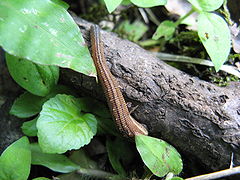- Haemadipsidae
-
Haemadipsidae 
Japanese Mountain Leech (Haemadipsa zeylanica) Scientific classification Kingdom: Animalia Subkingdom: Eumetazoa Phylum: Annelida Class: Clitellata Subclass: Hirudinea Infraclass: Euhirudinea Order: Arhynchobdellida Suborder: Hirudiniformes Family: Haemadipsidae
Blanchard, 1893Subfamily: Haemadipsinae (but see text)
Blanchard, 1893Genera 14, see text
Synonyms Domanibdellidae
Idiobdellidae
NesophilaemonidaeHaemadipsidae are a family of "jawed leeches". The latter might be (but probably are not) a natural, monophyletic group of hirudiniform proboscisless leeches. The scientific names mean "blood-drinkers"[citation needed]. These leeches have five pairs of eyes, with the last two separated by two eyeless segments. Most have two jaws, but some have three. The family is monotypic, containing only the subfamily Haemadipsinae, though as the family can apparently be divided into two or three distinct lineages, at least one of the proposed splits, while not a distinct family, might be a valid subfamily.[1]
Commonly known as jawed land leeches, these annelids are known from subtropical and tropical regions around the Indian and Pacific Ocean[1]. Well-known Haemadipsidae are for example the Indian Leech (Haemadipsa sylvestris) and the yamabiru or Japanese Mountain Leech (Haemadipsa zeylanica). Members of the family feed on blood, except Idiobdella which has adapted to eat small snails[1].
The other notable group of jawed blood-sucking leeches are the aquatic Hirudinidae. The Xerobdellidae are sometimes included in the Haemadipsidae, but their status as a distinct family is supported by sequence analysis of the nuclear 18S and 28S rDNA and mitochondrial COI genes as well as the anatomy of their sexual organs and nephridia; the latter are located at the belly rather than along the body sides as in the Haemadipsidae proper. All Xerobdellidae have three jaws.[1]
Haemadipsidae probably originate in the Triassic, more than 150 million years ago (mya). The diversification of the large Asian genus Haemadipsa probably did not take place until the Eocene, about 50 mya.[1]
Selected genera
- Amicibdella
- Chtonobdella
- Haemadipsa
- Hygrobdella
- Idiobdella
- Malagabdella
- Nesophilaemon
- Philaemon
- Phytobdella
Footnotes
References
- Borda, Elizabeth; Oceguera-Figueroa, Alejandro & Siddall, Mark E. (2008): On the classification, evolution and biogeography of terrestrial haemadipsoid leeches (Hirudinida: Arhynchobdellida: Hirudiniformes). Mol. Phylogenet. Evol. 46(1): 142–154. doi:10.1016/j.ympev.2007.09.006 (HTML abstract)
External links
Categories:- Leeches
Wikimedia Foundation. 2010.
